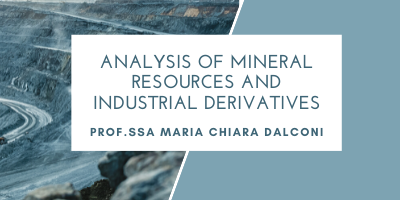Analysis of Mineral Resources and Industrial Derivatives

Period: first semester
Course Units Contents:
1) Industrial clay-based ceramics: raw materials and their characterisation, production processes, classification of ceramic products and their physical properties. Case studies: clay minerals; traditional bricks; new mix-design with recycled materials.
2) modern hydraulic binders (Portland cement): production process, characterization, cement classification, brief introduction to environmental issues related to cement and concrete production.
3) Asbestos containing wastes
4) X-ray powder diffraction: underlying theory, sample preparation and instrumental geometries, qualitative and quantitative analysis, analytical protocols for clay-minerals identification, advanced analysis of diffraction data (Rietveld method). Cases studies: clinker and cement, clay minerals, samples proposed by students.
5) image processing of 2D (SEM-BSE, PCM) and 3D (CT) images, and multispectral images (microchemical maps) for textural features (sand, matrix, pores) quantification and morphometric analysis. Case studies: ceramic materials, mortar-based materials, asbestos, and comparison with porous rocks.
Planned learning activities and teaching methods: Lectures; hands-on sample preparation for collecting powder diffraction data; exercise for quantitative phase analysis (software: High-Score Plus), digital image analysis (software: ImageJ, Multispec), statistical treatment of data (software: Excel, Statgraphics). Interactive learning with Moodle